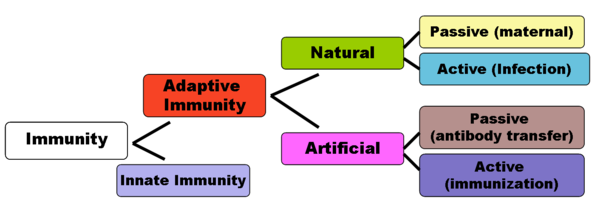ایمونولوژی
ایمنی شناسی پزشکیایمونولوژی
ایمنی شناسی پزشکیHumoral immunity

The humoral immune response (HIR) is the aspect of immunity that is mediated by macromolecules (as opposed to cell-mediated immunity) found in extracellular fluids such as secreted antibodies, complement proteins and certain antimicrobial peptides. Humoral immunity is so named because it involves substances found in the humours, or body fluids.
The study of the molecular and cellular components that comprise the immune system, including their function and interaction, is the central science of immunology. The immune system is divided into a more primitive innate immune system, and acquired or adaptive immune system of vertebrates, each of which contains humoral and cellular components.
Humoral immunity refers to antibody production and the accessory processes that accompany it, including: Th2 activation and cytokine production, germinal center formation and isotype switching, affinity maturation and memory cell generation. It also refers to the effector functions of antibody, which include pathogen and toxin neutralization, classical complement activation, and opsonin promotion of phagocytosis and pathogen elimination

B CELL
B Cells

Immunoglobulins. View credit information.
Each B cell is programmed to make one specific antibody. For example, one B cell will make an antibody that blocks a virus that causes the common cold, while another produces an antibody that attacks a bacterium that causes pneumonia. When a B cell encounters the kind of antigen that triggers it to become active, it gives rise to many large cells known as plasma cells, which produce antibodies.
- Immunoglobulin G, or IgG, is a kind of antibody that works efficiently to coat microbes, speeding their uptake by other cells in the immune system.
- IgM is very effective at killing bacteria.
- IgA concentrates in body fluids—tears, saliva, and the secretions of the respiratory and digestive tracts—guarding the entrances to the body.
- IgE, whose natural job probably is to protect against parasitic infections, is responsible for the symptoms of allergy.
- IgD remains attached to B cells and plays a key role in initiating early B cell responses.
Adaptive immune system
The adaptive immune system, also known as the specific immune system, is composed of highly specialized, systemic cells and processes that eliminate or prevent pathogenic growth. Thought to have arisen in the first jawed vertebrates, the adaptive or "specific" immune system is activated by the “non-specific” and evolutionarily older innate immune system (which is the major system of host defense against pathogens in nearly all other living things). The adaptive immune response provides the vertebrate immune system with the ability to recognize and remember specific pathogens (to generate immunity), and to mount stronger attacks each time the pathogen is encountered. It is adaptive immunity because the body's immune system prepares itself for future challenges.
The system is highly adaptable because of somatic hypermutation (a process of accelerated somatic mutations), and V(D)J recombination (an irreversible genetic recombination of antigen receptor gene segments). This mechanism allows a small number of genes to generate a vast number of different antigen receptors, which are then uniquely expressed on each individual lymphocyte. Because the gene rearrangement leads to an irreversible change in the DNA of each cell, all of the progeny (offspring) of that cell will then inherit genes encoding the same receptor specificity, including the Memory B cells and Memory T cells that are the keys to long-lived specific immunity. Immune network theory is a theory of how the adaptive immune system works, that is based on interactions between the variable regions of the receptors of T cells, B cells and of molecules made by T cells and B cells that have variable regions.
ادامه مطلب ...

The system is highly adaptable because of somatic hypermutation (a process of accelerated somatic mutations), and V(D)J recombination (an irreversible genetic recombination of antigen receptor gene segments). This mechanism allows a small number of genes to generate a vast number of different antigen receptors, which are then uniquely expressed on each individual lymphocyte. Because the gene rearrangement leads to an irreversible change in the DNA of each cell, all of the progeny (offspring) of that cell will then inherit genes encoding the same receptor specificity, including the Memory B cells and Memory T cells that are the keys to long-lived specific immunity. Immune network theory is a theory of how the adaptive immune system works, that is based on interactions between the variable regions of the receptors of T cells, B cells and of molecules made by T cells and B cells that have variable regions.

